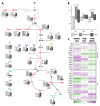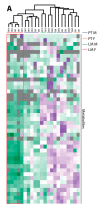Progression-Dependent Altered Metabolism in Osteosarcoma Resulting in Different Nutrient Source Dependencies
- PMID: 32471029
- PMCID: PMC7352851
- DOI: 10.3390/cancers12061371
Progression-Dependent Altered Metabolism in Osteosarcoma Resulting in Different Nutrient Source Dependencies
Abstract
Osteosarcoma (OS) is a primary malignant bone tumor and OS metastases are mostly found in the lung. The limited understanding of the biology of metastatic processes in OS limits the ability for effective treatment. Alterations to the metabolome and its transformation during metastasis aids the understanding of the mechanism and provides information on treatment and prognosis. The current study intended to identify metabolic alterations during OS progression by using a targeted gas chromatography mass spectrometry approach. Using a female OS cell line model, malignant and metastatic cells increased their energy metabolism compared to benign OS cells. The metastatic cell line showed a faster metabolic flux compared to the malignant cell line, leading to reduced metabolite pools. However, inhibiting both glycolysis and glutaminolysis resulted in a reduced proliferation. In contrast, malignant but non-metastatic OS cells showed a resistance to glycolytic inhibition but a strong dependency on glutamine as an energy source. Our in vivo metabolic approach hinted at a potential sex-dependent metabolic alteration in OS patients with lung metastases (LM), although this will require validation with larger sample sizes. In line with the in vitro results, we found that female LM patients showed a decreased central carbon metabolism compared to metastases from male patients.
Keywords: GC-MS; flux analysis; glucose; glutamine, sex and gender; osteosarcoma.
Conflict of interest statement
The authors declare no conflict of interest.
Figures






Similar articles
-
Glutaminase-1 (GLS1) inhibition limits metastatic progression in osteosarcoma.Cancer Metab. 2020 Mar 5;8:4. doi: 10.1186/s40170-020-0209-8. eCollection 2020. Cancer Metab. 2020. PMID: 32158544 Free PMC article.
-
Metabolomics uncovers a link between inositol metabolism and osteosarcoma metastasis.Oncotarget. 2017 Jun 13;8(24):38541-38553. doi: 10.18632/oncotarget.15872. Oncotarget. 2017. PMID: 28404949 Free PMC article.
-
The roles of glycolysis in osteosarcoma.Front Pharmacol. 2022 Aug 17;13:950886. doi: 10.3389/fphar.2022.950886. eCollection 2022. Front Pharmacol. 2022. PMID: 36059961 Free PMC article. Review.
-
miR-26b inhibits proliferation, migration, invasion and apoptosis induction via the downregulation of 6-phosphofructo-2-kinase/fructose-2,6-bisphosphatase-3 driven glycolysis in osteosarcoma cells.Oncol Rep. 2015 Apr;33(4):1890-8. doi: 10.3892/or.2015.3797. Epub 2015 Feb 12. Oncol Rep. 2015. PMID: 25672572
-
The role of Fas/FasL in the metastatic potential of osteosarcoma and targeting this pathway for the treatment of osteosarcoma lung metastases.Cancer Treat Res. 2009;152:497-508. doi: 10.1007/978-1-4419-0284-9_29. Cancer Treat Res. 2009. PMID: 20213411 Review.
Cited by
-
Metabolic reprogramming in osteosarcoma.Pediatr Discov. 2023 Jul 26;1(2):e18. doi: 10.1002/pdi3.18. eCollection 2023 Sep. Pediatr Discov. 2023. PMID: 40625719 Free PMC article. Review.
-
A Risk-Scoring Model Based on Evaluation of Ferroptosis-Related Genes in Osteosarcoma.J Oncol. 2022 Mar 28;2022:4221756. doi: 10.1155/2022/4221756. eCollection 2022. J Oncol. 2022. PMID: 35386212 Free PMC article.
-
Serum Starvation Accelerates Intracellular Metabolism in Endothelial Cells.Int J Mol Sci. 2023 Jan 7;24(2):1189. doi: 10.3390/ijms24021189. Int J Mol Sci. 2023. PMID: 36674708 Free PMC article.
-
Optimized Workflow for On-Line Derivatization for Targeted Metabolomics Approach by Gas Chromatography-Mass Spectrometry.Metabolites. 2021 Dec 18;11(12):888. doi: 10.3390/metabo11120888. Metabolites. 2021. PMID: 34940646 Free PMC article.
-
Harnessing multi‑omics to revolutionize understanding and management of osteosarcoma: A pathway to precision medicine (Review).Int J Mol Med. 2025 Jun;55(6):92. doi: 10.3892/ijmm.2025.5533. Epub 2025 Apr 17. Int J Mol Med. 2025. PMID: 40242955 Free PMC article. Review.
References
Grants and funding
LinkOut - more resources
Full Text Sources
Medical
Miscellaneous

